Doré, Drills, & Discoveries - Summer Solstice Tour
As the summer heats up so does exploration in the Yukon and Alaska. North of the 60th parallel the exploration season can be short due to the seasonality, but the jurisdiction is attractive due to the underexplored potential of the region and recent discoveries. We had the opportunity to visit five geologically related projects all at different stages in the Yukon and Alaska this summer for a hands-on look at why the area has attracted so much investor interest of late.
Geology knows no boundaries or borders. The Tintina Gold Province (figure 1) is a large geographical area stretching from the southern Yukon border to central Alaska and through to its western boundary. What’s exciting about this region is, along with producing mines (Victoria Gold’s Eagle Gold Mine and Kinross’s Fort Knox) there are still opportunities for new discoveries confirmed by Snowline Gold’s discovery late last year and Banyan Gold and Freegold Ventures prior to that.
Figure 1: Tintina Gold Province (grey dashed line) is a large geographical area that encompasses multiple gold deposits. Only selective deposits visited on the site tour shown here.
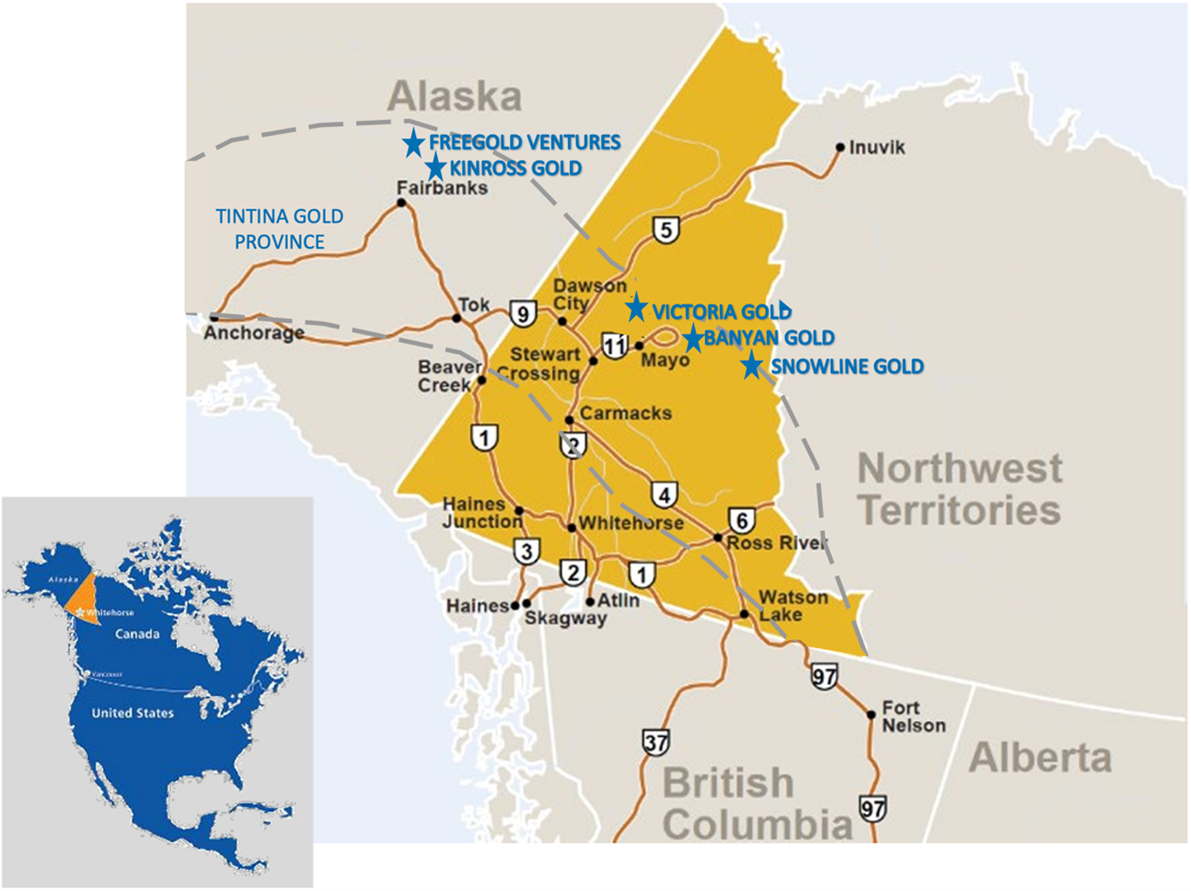
Our first stop was Victoria Gold’s Eagle mine which is Yukon’s largest gold mine. The Eagle Gold Mine is a heap leach deposit that can produce up to 200 koz of Au a year. The advantage of a heap leach mine is the low cost of production allowing mines to process lower grade ore than milling operations. The Eagle Gold mine has an open pit reserve grade of 0.64 gpt Au and 3.06 Moz of contained gold and the method of extracting this gold can be quite simple compared to other operations. The mineralized rock is blasted, loaded into haul trucks and then taken to a three-stage crushing circuit (figure 2) that reduces large 1 m sized boulders to 12.5-15 mm in size (about the size of a grape) gravel. This material is then transported via overland conveyors to the heap leach facility. Prior to stacking the ground is lined with a thick impermeable liner and then stacked in layers with plastic piping buried in the pad in sequential layers that delivers a cyanide rich solution which over time coats the mineralized material and leaches the gold from the crushed ore. The gold laden “pregnant” solution is then collected and sent to the gold recovery plant where gold is extracted from the solution using carbon adsorption columns and then plated on to cathodes using electrowinning cells. This process produces a gold sludge which is then smelted to produce gold doré.
Figure 2: Outlay of Victoria Gold’s Eagle Gold Mine. Note the open mineralization has the same orientation of the mountain thereby reducing the amount of waste rock required to be moved.
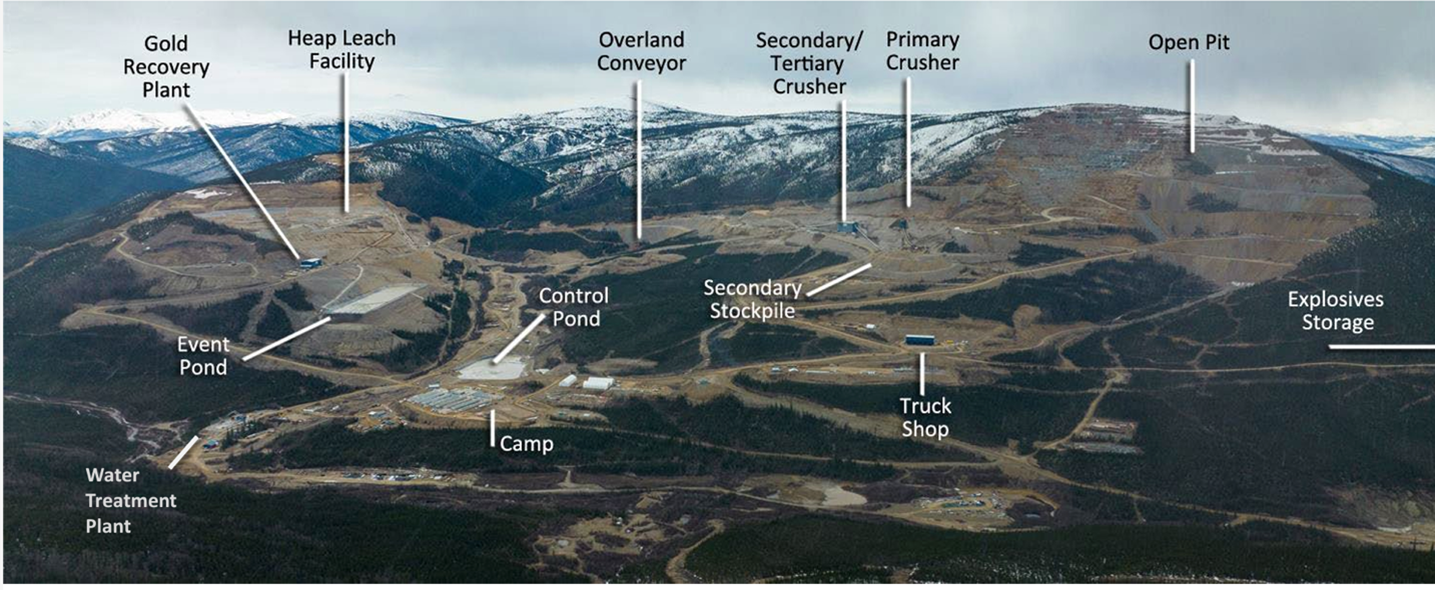
Our next stop was Banyan Gold’s AurMac deposit which hosts 6.2 Moz at 0.61 gpt Au. The project is located 30 km SE of the Eagle Gold Mine but is much earlier stage. Despite having a resource double the size of Eagle Gold Mine, Banyan’s project needs to deliver on some very important milestones. As mentioned, low grade deposits like these are best processed using heap leach methods and thus the metallurgy of the ore is always crucial. Metallurgy is the process used to extract metals from minerals or compounds demonstrating what percentage of the metal can be recovered. Very preliminary results indicate ~90% recoveries for the AurMac mineralization but further tests are warranted.
One of the most exciting stories in the gold sector over the last year and a half has been Snowline Gold’s Rogue Valley discovery (figure 3). While no resource has been announced for the project yet due to the stage of the project, estimates on the street vary from 5-10 Moz at ~1 gpt Au. The Berdahl family, who is behind the discovery, have been prospecting this area since the 1980’s and had spent a good part of the last decade trying to option the current properties to other companies in order to continue to advance the projects. As luck would have it, the family decided to create their own company and with some key investors, raised enough money for an initial drill program which became an overnight success. The multi-million-ounce potential of the project has set off a modern-day gold rush with companies staking up ground all in and around the region. Despite the great discovery though the deposit does not come without challenges. Critical infrastructure (power and roads) is lacking, and the remoteness of the project will be a major hurdle that will need to be overcome.
After the multiple helicopter rides, charter flights, and bumpy gravel roads endured visiting the Yukon properties we were off to Alaska to visit Kinross’s Fort Knox Mine and Freegold Venture’s Golden Summit project (figure 3). The Golden Summit hosts ~20 Moz at ~0.90 gpt Au and is a thirty-minute drive from Fairbanks and just eight kilometres north of the Fort Knox mine. Despite, the huge gold endowment, excellent infrastructure and a producing mine nearby, the metallurgy required to extract the gold is quite complex which has been a major hurdle for the company. The company is focused on additional exploration on their property and more detailed metallurgy work. Results will be released late this year.
Figure 3: (Left) Snowline Gold’s Rogue Valley deposit. Red dashed outline shows the rough outline of the deposit. Note the rugged terrain compared to Freegold Ventures Golden Summit project (right).
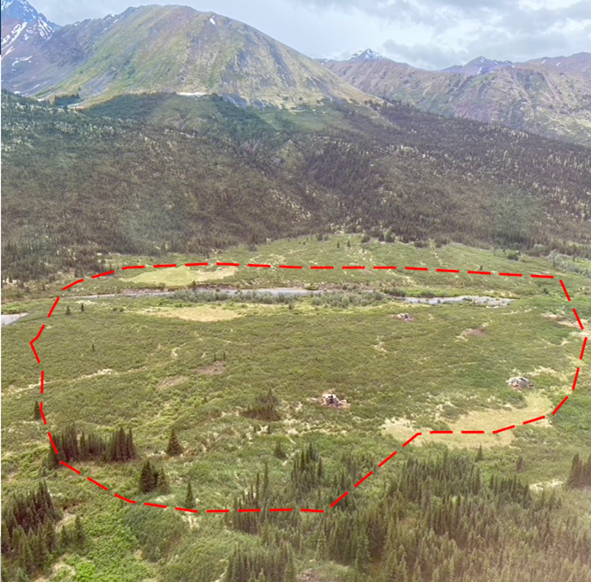
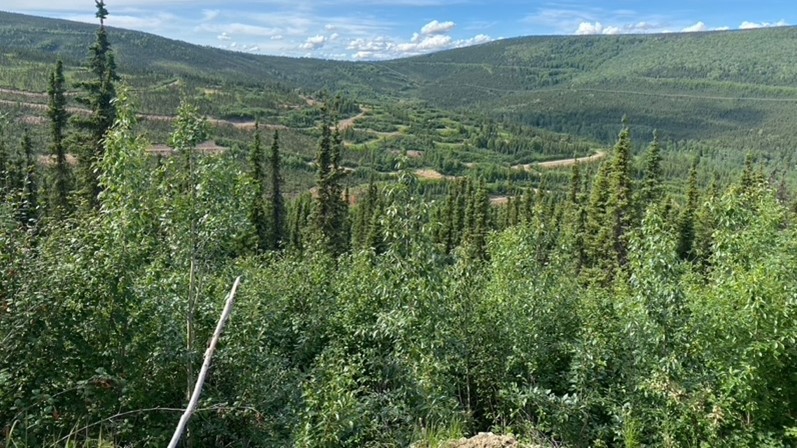
Our last and final visit was to Kinross’s Fort Knox Mine which started off as a milling operation back in 1996 and then added a heap leach circuit in 2009. The project is located 42 km NE of Fairbanks and has produced over 8 Moz over its 25+ years in operation. Unlike in person, it’s difficult to ascertain from the photograph (figure 4) that the Fort Knox operation is six times bigger than Victoria Gold’s Eagle Gold Mine. Fort Knox processes 60 million tonnes of material per year to produce close to 225 koz of gold and is an example of just how large and well-endowed these systems can be.
Figure 4: The main pit at Fort Knox. The pit is estimated to be greater than 2 kilometres along strike (lengthwise) and ~650 metres in depth.
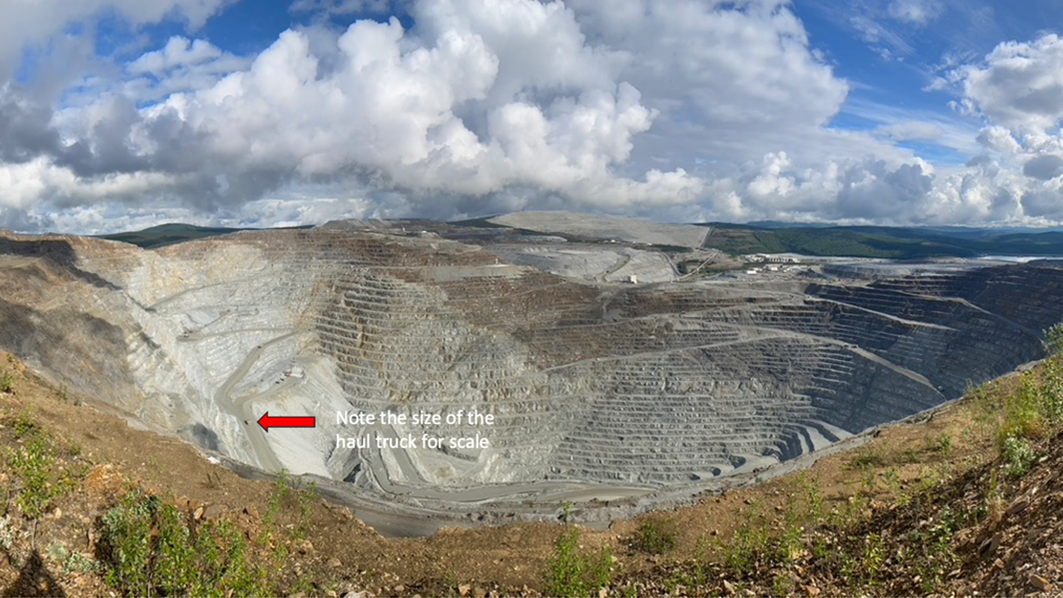
“This means that” gold exploration continues to be boom and bust business especially North of the 60th parallel. After several major discoveries in the early 2000’s this area was one of the hottest jurisdictions for mining exploration. However, as challenges with infrastructure arose excitement in the region began to diminish. Since then, many major mining companies have once again begun to invest in junior explorers in the region as new discoveries are made and the construction of new mines has shown the viability of building projects here. Many factors must align for a deposit to be built and even then, challenges can still arise. However, as in the Klondike gold rush days, the Yukon and Alaska still offer plenty of opportunities to hit the big one through discovery. Armed with a better understanding of these particular gold systems, we look forward to sifting through the cobble to discover the nugget that will kick of the next gold rush.
National Instrument 31-103 requires registered firms to disclose information that a reasonable investor would expect to know, including any material conflicts with the firm or its representatives. Doug Johnson and/or Pathfinder Asset Management Limited are an insider of companies periodically mentioned in this report. Please visit www.paml.ca for full disclosures.
Changes in Leverage. We are increasing the asset ceiling to 2.0 times the market value of equity for Pathfinder International Fund and Pathfinder Real Fund to be consistent with Pathfinder Partners’ Fund and Pathfinder Resource Fund
*All returns are time weighted and net of investment management fees. Returns from the Pathfinder Partners’ Fund and Partners’ Real Return Plus Fund are presented based on the masters series of each fund. The Pathfinder Core: Equity Portfolio and The Pathfinder Core: High Income Portfolio are live accounts. These are actual accounts owned by the Pathfinder Chairman (Equity) and client (High Income) which contain no legacy positions, cash flows or other Pathfinder investment mandates or products. Monthly inception dates for each fund and portfolio are as follows: Pathfinder Core: Equity Portfolio (January 2011), Pathfinder Core: High Income Portfolio (October 2012) Partners’ Fund (April 2011), Partners’ Real Return Plus Fund (April, 2013), and Partners’ Core Plus Fund (November 2014).
Pathfinder Asset Management Limited (PAML) and its affiliates may collectively beneficially own in excess of 10% of one or more classes of the issued and outstanding equity securities mentioned in this newsletter. This publication is intended only to convey information. It is not to be construed as an investment guide or as an offer or solicitation of an offer to buy or sell any of the securities mentioned in it. The author has taken all usual and reasonable precautions to determine that the information contained in this publication has been obtained from sources believed to be reliable and that the procedures used to summarize and analyze such information are based on approved practices and principles in the investment industry. However, the market forces underlying investment value are subject to sudden and dramatic changes and data availability varies from one moment to the next. Consequently, neither the author nor PAML can make any warranty as to the accuracy or completeness of information, analysis or views contained in this publication or their usefulness or suitability in any particular circumstance. You should not undertake any investment or portfolio assessment or other transaction on the basis of this publication, but should first consult your portfolio manager, who can assess all relevant particulars of any proposed investment or transaction. PAML and the author accept no liability of any kind whatsoever or any damages or losses incurred by you as a result of reliance upon or use of this publication.